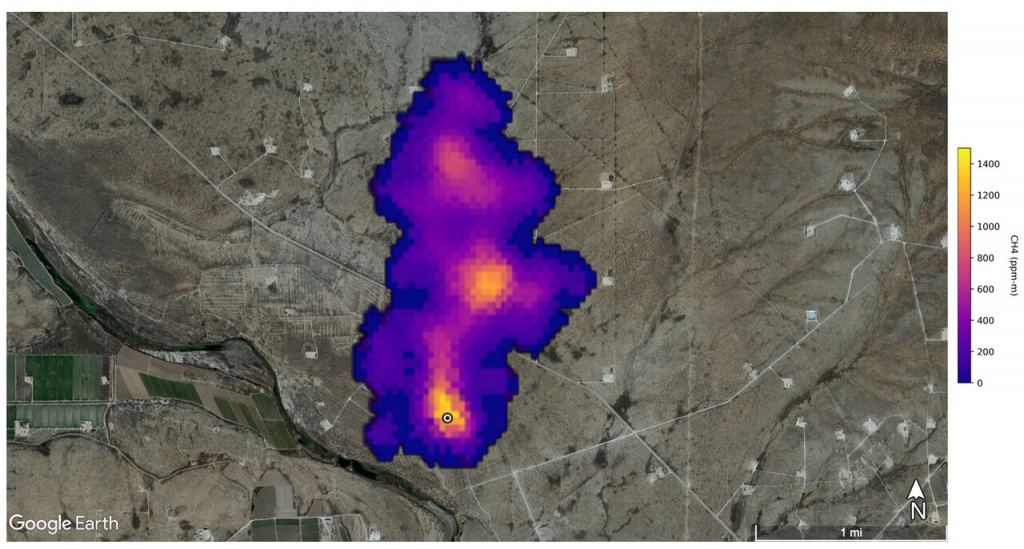Everybody’s heard of methane. It’s a major part of the atmosphere in places like Uranus and Neptune. On Earth, it’s also part of our atmosphere, where it works to warm things up.
Some of it gets there from natural causes. But, a lot of it comes from industrial super-emitters and other human-caused processes. That’s not good because too much methane works, along with other greenhouse gases (like carbon dioxide, or CO2) to “over warm” our atmosphere.
In the right amounts, methane’s role in warming the atmosphere is perfectly normal. For humans, methane has other uses. It’s a big component of natural gas, used for everything from cooking to heating our homes and businesses.
But, the releases of methane from big industrial processes, outgassing from landfills, and oil and gas exploration are not normal. They all contribute to climate change. How to track methane emissions? It turns out this gas can be detected from space and has been for some time.
Currently, a satellite called EMIT (for Earth Surface Mineral Dust Source Investigation) is using spectroscopic studies to find big clouds of methane. There are at least 50 “super-emitters” of methane in EMIT’s data, and their existence is cause for concern. Unfortunately, scientists expect to find more as time goes by.
The cube (left) shows methane plumes (purple, orange, yellow) over super-emitters in Turkmenistan. The rainbow colors are the spectral fingerprints from corresponding spots in the front image. The blue line in the graph (right) shows the methane fingerprint EMIT detected; the red line is the expected fingerprint based on an atmospheric simulation.
Credit: NASA/JPL-Caltech Super-emitters deliver methane to the atmosphere at very high rates. How high? “Some of the plumes EMIT detected are among the largest ever seen – unlike anything that has ever been observed from space,” said Andrew Thorpe, a researcher at JPL leading the EMIT methane effort. “What we’ve found in just a short time already exceeds our expectations.
” Infamous Super-emitters EMIT has been busy. For example, it detected a plume about 3. 3 kilometers long southeast of Carlsbad, New Mexico.
It’s smack dab over the Permian Basin, one of the largest oilfields in the world. EMIT also found 12 plumes from oil and gas infrastructure in Turkmenistan, some stretching over 32 kilometers. In Iran, near Tehran, there’s a plume at least 4.
8 kilometers long. It’s blowing out from a waste-processing plant. These are all known super-emitters.
The flow rates of gas into the atmosphere from these sites are dismaying. In the Permian basin, the flow rate is 18,300 kilograms per hour. The Turkmenistan plumes are sending 50,400 kilograms per hour in total into the atmosphere.
That’s roughly similar to a gas leak in the 2015 Aliso Canyon event in California. It sent 50,000 kilograms per hour into the air at various times and was among the largest methane releases in U. S.
history. Curtailing Methane Gas Emissions The fight to reduce greenhouse gases is an important one in the effort to slow global warming. Scientists do use ground-based methods to find methane emissions.
However, space-based detectors deliver clearer looks at where it and other gases are polluting the atmosphere. “Reining in methane emissions is key to limiting global warming. This exciting new development will not only help researchers better pinpoint where methane leaks are coming from, but also provide insight on how they can be addressed – quickly,” said NASA Administrator Bill Nelson.
“The International Space Station and NASA’s more than two dozen satellites and instruments in space have long been invaluable in determining changes to the Earth’s climate. EMIT is proving to be a critical tool in our toolbox to measure this potent greenhouse gas – and stop it at the source. ” While CO2 is the prime greenhouse gas in the news most of the time, methane is critically important to regulate, too.
It makes up a smaller fraction of human-caused greenhouse-gas emissions than CO2. However, methane is roughly 80 times more effective at trapping heat in the atmosphere for 20 years after it is released. It also stays in the atmosphere over shorter time periods, compared to CO2.
Its short lifetime in our air does have an upside. If we can curtail methane emissions, the atmosphere will see improvement more quickly. That leads to a slower warming cycle in the short term.
Finding More Methane Super-emitters EMIT will likely find many more super-emitters. “As it continues to survey the planet, EMIT will observe places in which no one thought to look for greenhouse-gas emitters before, and it will find plumes that no one expects,” said Robert Green, EMIT’s principal investigator at JPL. The mission is the first of a new class of spaceborne imaging spectrometers to study Earth.
Another is the Carbon Plume Mapper (CPM), designed to detect methane and CO2. JPL is working with a nonprofit, Carbon Mapper, along with other partners, to launch two satellites equipped with CPM in late 2023. Identifying methane point sources is a huge step in the process of reducing greenhouse gases.
EMIT supplies knowledge of the locations of big emitters, and that gives operators of the super-emitter facilities the chance to take quick action. The ultimate goal is to reduce or even eliminate the release of methane into our already warming atmosphere. The EMIT observations aren’t the first ones to detect methane emissions on Earth.
GHGSat, which is a private company that monitors such emissions from space spotted leaks from the Nordstream pipeline between Denmark and Sweden. The pipeline was sabotaged and emitted methane at 79,000 kg per hour. For More Information Methane ‘Super-Emitters’ Mapped by NASA’s New Earth Space MissionU.
S. Methane “Hotspot” is Snapshot of Local Pollution The post NASA is Mapping Giant Clouds of Methane Released by “Super-Emitters” Across the World appeared first on Universe Today. .
From: universetoday
URL: https://www.universetoday.com/158353/nasa-is-mapping-giant-clouds-of-methane-released-by-super-emitters-across-the-world/



